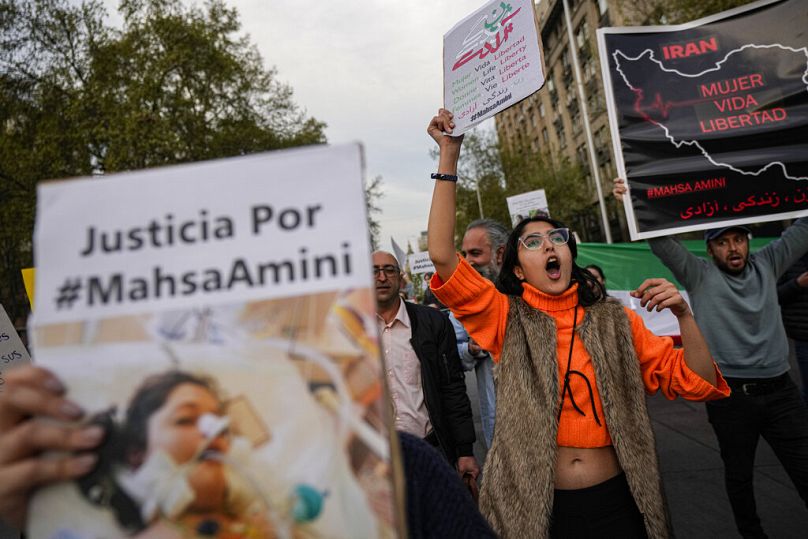After a week of anti-government protests, with hundreds arrested and dozens killed, Iran's President Raisi likened demonstrators to enemies of the state.
Anti-government protests have continued across Iran, despite efforts of pro-regime rallies to bolster the country's leadership.
Authorities in the north of the country said Saturday they arrested 739 people, including 60 women, on charges of taking part in demonstrations.
At least 35 people have been killed so far in the violent protests, which have continued for more than a week following the death of a young woman arrested by the morality police.
Mahsa Amini, 22, was detained on 13 September in Tehran for "wearing inappropriate clothing" by police enforcing the Islamic Republic's strict dress code.
She died three days later in hospital, and her death led to night-time protests in major Iranian cities, including the capital Tehran.
Videos on social media showed protesters in Tehran torching a police car and confronting officers. Others showed gunfire ringing out as protesters bolt from riot police, shouting: “They are shooting at people! Oh my God, they're killing people!”
In the northwestern city of Neyshabur, protesters cheered over an overturned police car. Footage from Tehran and Mashhad showed women waving their obligatory headscarves, known as hijab, in the air like flags while chanting, “Freedom!"
Separately, hackers have targeted a number of government websites in recent days, taking some of them down at least briefly. On Friday, hackers interrupted Iran's Channel 3 on a popular streaming website and played videos in support of the protests. Normal programming was restored a couple of minutes later.
The protests have grown into an open challenge to the theocracy established after the 1979 Islamic Revolution. The chants have been scathing, with some chanting “Death to the dictator!” and “Mullahs must be gone!”
Thousands of counterprotesters took part in pro-government rallies on Friday in a show of support for authorities, who claimed the events were spontaneous.
In Tehran, waving Iranian flags, demonstrators chanted slogans against America and Israel, according to state media, reflecting the official line that blames the latest unrest on hostile foreign countries.
Iran has also disrupted internet access and tightened restrictions on popular platforms like Instagram and WhatsApp, which can be used to organize rallies. In response, the US Treasury Department said it would allow American tech firms to expand their business in Iran to boost internet access for the Iranian people. Iran is under heavy US and international sanctions.
The death of Mahsa Amini has sparked sharp condemnation from Western countries and the United Nations, which has called for an investigation into what happened.
Iranians across at least 13 cities from the capital, Tehran, to Amini's northwest Kurdish hometown of Saqez have poured into the streets, voicing pent-up anger over social and political repression.
There have also been protests in other countries - including in Germany, Brazil and Chile - and some Iranians abroad have been cutting their hair and burning hijabs in front of Iranian embassies.
“The death has tapped into broader antigovernment sentiment in the Islamic Republic and especially the frustration of women,” wrote political risk firm Eurasia Group. It noted that Iran’s hard-liners have intensified their crackdown on women’s clothing over the past year since former judiciary chief Ebrahim Raisi became president.
“The prospect of the leadership offering concessions to Iranian women is minimal,” it said. “In the cold calculus of Iranian leaders, the protests have likely gone far enough and a more forceful response is required to quell the unrest.”
Raisi condemned the protests as he arrived back in Iran after addressing the United Nations General Assembly earlier this week.
“We have announced many times that if anyone has a fair comment, we will listen to it. But anarchy? Disturbing national security? The security of people? No one will succumb to this,” he said.
London-based watchdog Amnesty International has accused security forces of beating protesters with batons and firing metal pellets at close range. Videos show police and paramilitary officers using live fire, tear gas and water cannons to disperse demonstrators.
Iran has grappled with waves of protests in the recent past, mainly over a long-running economic crisis exacerbated by American sanctions linked to its nuclear program. In November 2019, the country saw the deadliest violence since the revolution, as protests erupted over gas price hikes.
Economic hardship remains a major source of anger today as the prices of basic necessities soar and the Iranian currency declines in value.












